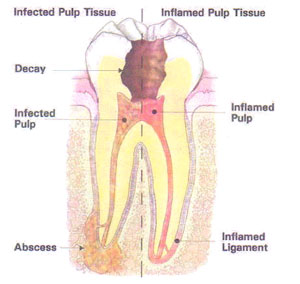What is Endodontic Surgery?

The most common endodontic surgical procedure is called an apicoectomy or root-end resection. When inflammation or infection persists in the bony area
around the end of your tooth after endodontic treatment, Dr. Wolfson may perform an apicoectomy.
In this procedure,
Dr. Wolfson opens the gum
tissue near the tooth to expose the underlying bone, and the infected tissue is removed. The very end of the root is also removed, and a small filling may be
placed to seal the root canal. Local anaesthetics make the procedure comfortable, and most patients return to their normal activities the next day.
Endodontic Treatment can often be performed in one or two visits and involves the following steps:
Step 1
Dr. Wolfson examines and x-rays the tooth, then administers local anaesthetic.
After the tooth is numb,
Dr. Wolfson places a small protective
sheet called a "dental dam" over the area to isolate the tooth and keep it clean and free of saliva during the procedure.
Step 2
An opening is made in the top of the tooth. Very small instruments are used to clean away the disease from the canals, sterilize the area and then shape the space for a filling.
Step 3
After the space is cleaned and shaped, the the root canals are filled with a biocompatible material, usually a rubber-like
material called
"gutta-percha".
The gutta-percha completely seals the root canals, and in most cases, a temporary filling is placed to close the opening. The temporary filling
will be removed by your dentist before the tooth is restored.
Step 4
After the final visit with Dr. Wolfson you must return to your dentist to have a crown or other restoration placed on the tooth to protect
and restore it to full function.
If the tooth lacks sufficient structure to hold the
restoration in place, your dentist or Dr. Wolfson can still
successfully treat the tooth by placing a post inside the
tooth for support. Ask your dentist or Dr. Wolfson for more
details about the specific restoration planned for your
tooth.
Will the Tooth Need any Special Care or Additional Treatment?
You should not chew or bite on the treated tooth until you have had it restored by your dentist. The unrestored tooth is susceptible to fracture, so you should see your dentist for a full restoration as soon as possible. Otherwise, you need only practice good oral hygiene, including brushing, flossing, and regular check-ups and cleanings. Most endodontically treated teeth last as long as other natural teeth. In a few cases, a tooth that has undergone endodontic treatment fails to heal or the pain continues, as a result of resistant infection. If this happens, another endodontic procedure can still save the tooth. What causes an endodontically treated tooth to need additional treatment? New trauma, deep decay, or a loose, cracked or broken filling can cause new infection in your tooth. In some cases, the endodontist may discover very narrow or curved canals that could not be treated during the initial procedure.

